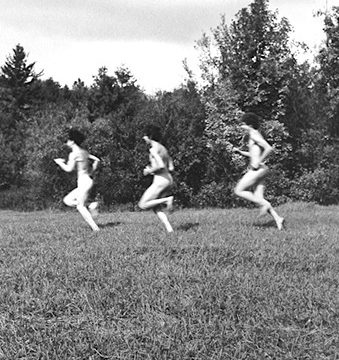Taxpayers stripped of $117,521 for naked hippie commune research

HIPPIE RESEARCH: This photo of nude hippies running is part of a collection of Rebecca Lepkoff “Hippie” photos donated to the Vermont Historical Society.
By Bruce Parker | Vermont Watchdog
Americans will soon get the full monty on the hippie commune movement that invaded Vermont in the 1970s, thanks to a federal grant from the Institute of Museum and Library Services. The taxpayer-funded historical project about oft-nude, drug-addled drifter colonies earned a No. 16 ranking in the 2014 Wastebook report on wasteful government spending.
With $117,521 supplied by taxpayers, the Vermont Historical Society has begun work on “Colleges, Communes and Coops: 1970’s Counterculture and Its Lasting Influence on Vermont.” The two-year research project aims to provide a nostalgic insider look at the nearly 100 hippie farms that overtook Vermont following the Vietnam War youth protest movement.
The project, which ranks No. 16 in this year’s 2014 Wastebook report published by the office of Oklahoma U.S. Sen. Tom Coburn, may leave little unexposed. Of the 50-plus oral histories being gathered for display in a future exhibit, symposium and statewide public program, many are likely to echo the personal experiences of commune members who have spoken openly about the farms in recent years.
“I always liked walking around barefoot and going around naked,” recalls Peter Simon, brother of singer Carly Simon and a resident of Tree Frog Farm commune.
“Everything was shared. We shared food. We shared sex. We shared clothing,” said Simon during a promo session for a 2010 photography exhibit titled “Vermont Hippies from the Seventies.”
As described by members, the Tree Frog Farm commune was dedicated to “nudity, psychedelic drugs and free love.”
A member of the nearby Free Farm recalls the public “being offended by all the weeds and the bare-breasted women,” which eventually led to a standoff with the local sheriff.
The communes were two of many across Guilford and Putney, with funky names such as Total Loss Farm, Toad Hall, Johnson Pasture, Red Clover Collective and Wooden Shoe. The farms became home to thousands of idealist youth dropping out of society.
The Vermont Historical Society project aims to demonstrate the historical link between the free-love, vagabond communards of the 1970s and Vermont’s progressive politics, organic farm movement and environmentalist culture today.
“Receiving a grant from the IMLS is a significant achievement. IMLS grants are highly competitive — library and museum professionals from throughout the United States review grant applications and make recommendations on projects most worthy of funding,” Executive Director Mark Hudson said in a statement announcing the project in September.
“By collecting objects, papers, and oral histories we will be creating a body of information for this pivotal period in our state history, making it available for generations to come,” said Jackie Calder, curator at Vermont Historical Society.
Published annually, the Wastebook report highlights absurd uses of taxpayer money by government. Other examples from this year’s report include an Ohio State University rabbit massage study and the marketing of alpaca poop fertilizer in Virginia.
Contact Bruce Parker at bparker@watchdog.org







